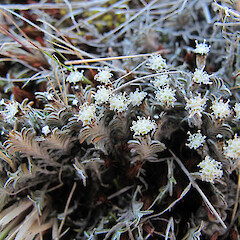Raoulia monroi
Common name
fan-leaved mat daisy
Synonyms
Raoulia cheesemanii Beauverd
Family
Asteraceae
Flora category
Vascular – Native
Endemic taxon
Yes
Endemic genus
Yes
Endemic family
No
Structural class
Herbs - Dicotyledonous composites
NVS code
The National Vegetation Survey (NVS) Databank is a physical archive and electronic databank containing records of over 94,000 vegetation survey plots - including data from over 19,000 permanent plots. NVS maintains a standard set of species code abbreviations that correspond to standard scientific plant names from the Ngä Tipu o Aotearoa - New Zealand Plants database.
RAOMON
Chromosome number
2n = 28
Current conservation status
The conservation status of all known New Zealand vascular plant taxa at the rank of species and below were reassessed in 2017 using the New Zealand Threat Classification System (NZTCS) – more information about this can be found on the NZTCS website. This report includes a statistical summary and brief notes on changes since 2012 and replaces all previous NZTCS lists for vascular plants.
Please note, threat classifications are often suggested by authors when publications fall between NZTCS assessment periods – an interim threat classification status has not been assessed by the NZTCS panel.
- Conservation status of New Zealand indigenous vascular plants, 2017 . 2018. Peter J. de Lange, Jeremy R. Rolfe, John W. Barkla, Shannel P. Courtney, Paul D. Champion, Leon R. Perrie, Sarah M. Beadel, Kerry A. Ford, Ilse Breitwieser, Ines Schönberger, Rowan Hindmarsh-Walls, Peter B. Heenan and Kate Ladley. Department of Conservation. Source: NZTCS and licensed by DOC for reuse under the Creative Commons Attribution 4.0 International licence.
2017 | Threatened – Nationally Vulnerable | Qualifiers: DP, PD, RR, Sp
Previous conservation statuses
2012 | At Risk – Declining | Qualifiers: DP, RR, Sp
2009 | At Risk – Declining | Qualifiers: DP
2004 | Gradual Decline
Distribution
Endemic. New Zealand: South Island (Nelson, Marlborough, Canterbury and Otago).
Habitat
Lowland to upland open ground and rocky places, on river terraces and stabilised river gravel.
Detailed description
Stems prostrate, creeping and rooting; final branchlets ascending; forming close to open flat patches. Leaves closely distichously arranged, 2–3 mm. long, linear-oblong to oblong-spathulate, obtuse, sometimes apiculate; basal portion 3-nerved, membranous, clad in appressed white tomentum; apical portion spreading, involute; ventral surface ± densely clad in matted tomentum; dorsal surface with appressed dense to sparse tomentum. Capitula up to 5 mm diameter. Inner series of involucral bracts 3–5 × c. 1 mm, linear-oblong, glabrous except for sparse hairs at tips, pale yellow-green, margins hyaline, obtuse tips usually dark brown. Florets ± 15, female 8–10. Achenes c. 1 mm long, papillate-pubescent; pappus-hairs slender, papillae very finely claviform, c. 3.5 mm long, not thickened at tips.
Similar taxa
Other Raoulia species. Leaves of R. monroi are arranged in one plane, in two rows along the stem.
Flowering
No information
Fruiting
No information
Propagation technique
Easily grown from rooted pieces. Likes freely draining soil and hot sunny conditions. Intolerant of humidity.
Threats
As a lowland to montane species of dry, open ground this species is vulnerable to compeition from taller, more aggressive weed species. Although exact details are not yet available there is some evidence that suggests this species has been lost from some parts of its range and is actively declining in others.
Etymology
raoulia: Named after Étienne Fiacre Louis Raoul (23 July 1815–30 March 1852) who was a French naval surgeon and naturalist. He published a book Choix de plantes de la Nouvelle-Zélande (“Selected plants of New Zealand”) in 1846. The genus was named after him by Joseph Hooker.
monroi: Named after Sir David Monro who was a 19th century New Zealand politician
Attribution
Description adapted from Allan (1961).
References and further reading
Allan HH. 1961. Flora of New Zealand, Volume I. Indigenous Tracheophyta: Psilopsida, Lycopsida, Filicopsida, Gymnospermae, Dicotyledones. Government Printer, Wellington, NZ. 1085 p.












